2006 DODGE RAM SRT-10 wheel
[x] Cancel search: wheelPage 4345 of 5267
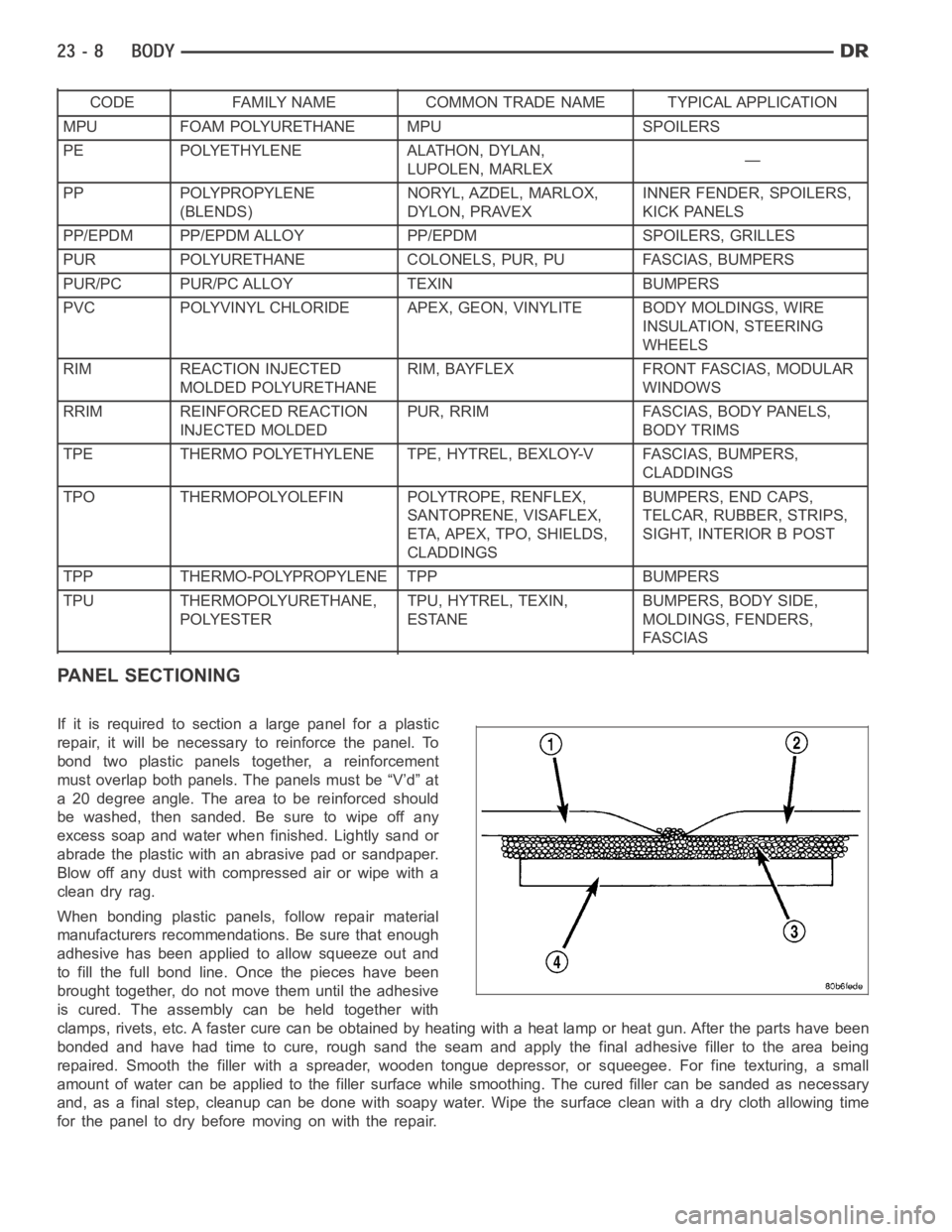
CODE FAMILY NAME COMMON TRADE NAME TYPICAL APPLICATION
MPU FOAM POLYURETHANE MPU SPOILERS
PE POLYETHYLENE ALATHON, DYLAN,
LUPOLEN, MARLEX—
PP POLYPROPYLENE
(BLENDS)NORYL, AZDEL, MARLOX,
DYLON, PRAVEXINNER FENDER, SPOILERS,
KICK PANELS
PP/EPDM PP/EPDM ALLOY PP/EPDM SPOILERS, GRILLES
PUR POLYURETHANE COLONELS, PUR, PU FASCIAS, BUMPERS
PUR/PC PUR/PC ALLOY TEXIN BUMPERS
PVC POLYVINYL CHLORIDE APEX, GEON, VINYLITE BODY MOLDINGS, WIRE
INSULATION, STEERING
WHEELS
RIM REACTION INJECTED
MOLDED POLYURETHANERIM, BAYFLEX FRONT FASCIAS, MODULAR
WINDOWS
RRIM REINFORCED REACTION
INJECTED MOLDEDPUR, RRIM FASCIAS, BODY PANELS,
BODY TRIMS
TPE THERMO POLYETHYLENE TPE, HYTREL, BEXLOY-V FASCIAS, BUMPERS,
CLADDINGS
TPO THERMOPOLYOLEFIN POLYTROPE, RENFLEX,
SANTOPRENE, VISAFLEX,
ETA, APEX, TPO, SHIELDS,
CLADDINGSBUMPERS, END CAPS,
TELCAR, RUBBER, STRIPS,
SIGHT, INTERIOR B POST
TPP THERMO-POLYPROPYLENE TPP BUMPERS
TPU THERMOPOLYURETHANE,
POLYESTERTPU, HYTREL, TEXIN,
ESTANEBUMPERS, BODY SIDE,
MOLDINGS, FENDERS,
FASCIAS
PANEL SECTIONING
If it is required to section a large panel for a plastic
repair, it will be necessary to reinforce the panel. To
bond two plastic panels together, a reinforcement
must overlap both panels. The panels must be “V’d” at
a 20 degree angle. The area to be reinforced should
be washed, then sanded. Be sure to wipe off any
excess soap and water when finished. Lightly sand or
abrade the plastic with an abrasive pad or sandpaper.
Blow off any dust with compressed air or wipe with a
clean dry rag.
When bonding plastic panels, follow repair material
manufacturers recommendations. Be sure that enough
adhesive has been applied to allow squeeze out and
to fill the full bond line. Once the pieces have been
brought together, do not move them until the adhesive
is cured. The assembly can be held together with
clamps, rivets, etc. A faster cure can be obtained by heating with a heat lamp or heat gun. After the parts have been
bonded and have had time to cure, rough sand the seam and apply the final adhesive filler to the area being
repaired. Smooth the filler with a spreader, wooden tongue depressor, or squeegee. For fine texturing, a small
amount of water can be applied to the filler surface while smoothing. The cured filler can be sanded as necessary
and, as a final step, cleanup can be done with soapy water. Wipe the surface clean with a dry cloth allowing time
for the panel to dry before moving on with the repair.
Page 4347 of 5267
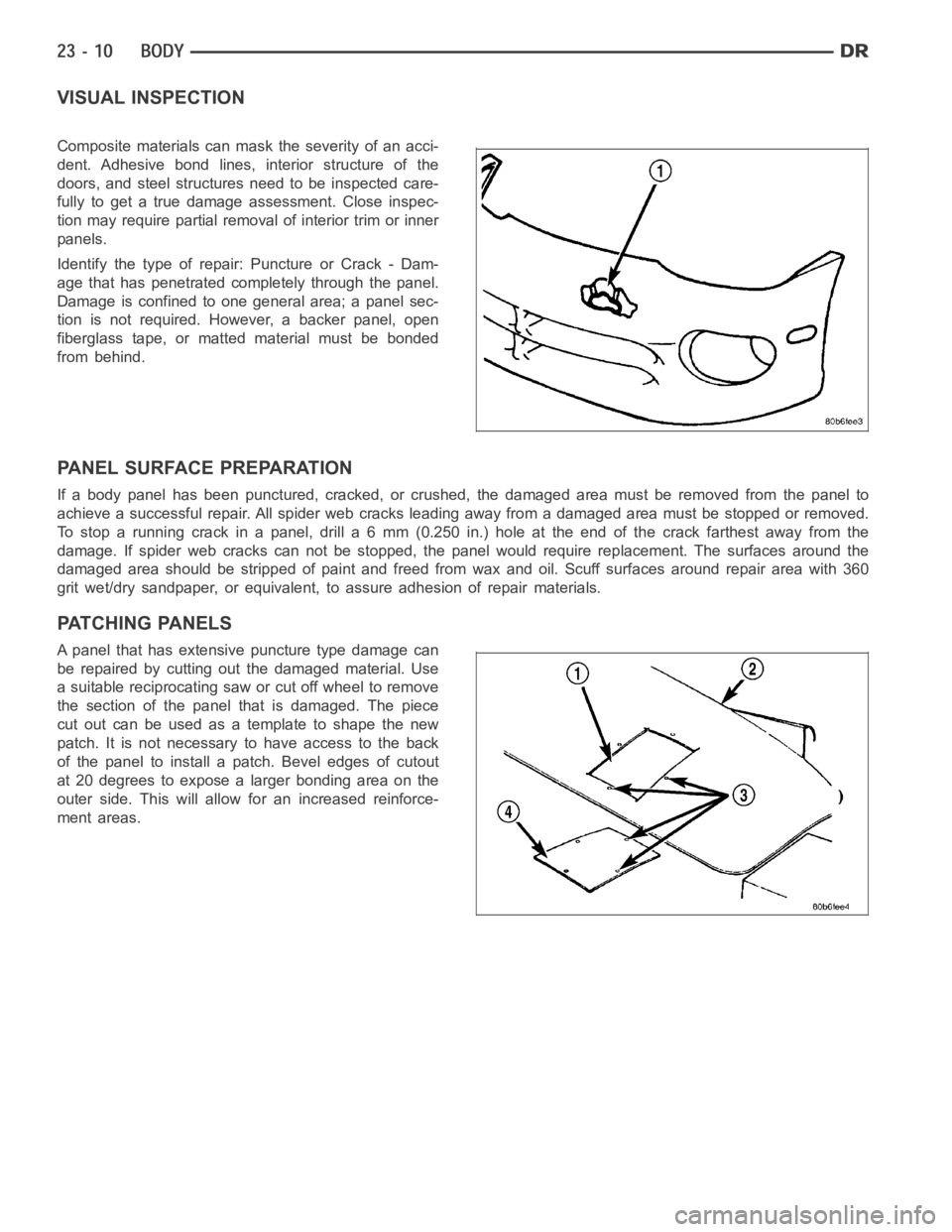
VISUAL INSPECTION
Composite materials can mask the severity of an acci-
dent. Adhesive bond lines, interior structure of the
doors, and steel structures need to be inspected care-
fully to get a true damage assessment. Close inspec-
tion may require partial removal of interior trim or inner
panels.
Identify the type of repair: Puncture or Crack - Dam-
age that has penetrated completely through the panel.
Damage is confined to one general area; a panel sec-
tion is not required. However, a backer panel, open
fiberglass tape, or matted material must be bonded
from behind.
PANEL SURFACE PREPARATION
If a body panel has been punctured, cracked, or crushed, the damaged area must be removed from the panel to
achieve a successful repair. All spider web cracks leading away from a damaged area must be stopped or removed.
To stop a running crack in a panel, drill a 6 mm (0.250 in.) hole at the end of the crack farthest away from the
damage. If spider web cracks can not be stopped, the panel would require replacement. The surfaces around the
damaged area should be stripped of paint and freed from wax and oil. Scuff surfaces around repair area with 360
grit wet/dry sandpaper, or equivalent, to assure adhesion of repair materials.
PATCHING PANELS
A panel that has extensive puncture type damage can
be repaired by cutting out the damaged material. Use
a suitable reciprocating saw or cut off wheel to remove
the section of the panel that is damaged. The piece
cut out can be used as a template to shape the new
patch. It is not necessary to have access to the back
of the panel to install a patch. Bevel edges of cutout
at 20 degrees to expose a larger bonding area on the
outer side. This will allow for an increased reinforce-
ment areas.
Page 4423 of 5267
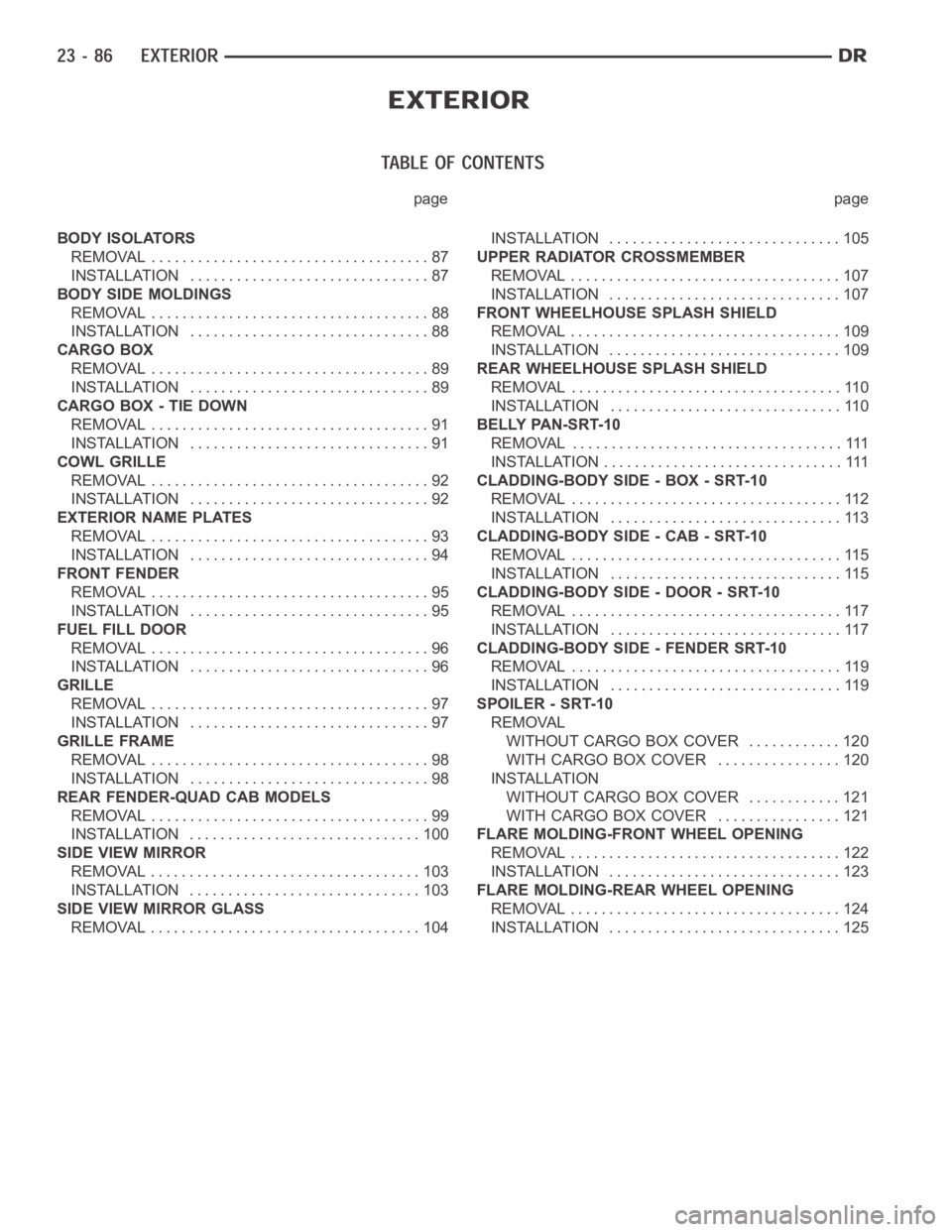
page page
BODY ISOLATORS
REMOVAL .................................... 87
INSTALLATION ............................... 87
BODY SIDE MOLDINGS
REMOVAL .................................... 88
INSTALLATION ............................... 88
CARGO BOX
REMOVAL .................................... 89
INSTALLATION ............................... 89
CARGO BOX - TIE DOWN
REMOVAL .................................... 91
INSTALLATION ............................... 91
COWL GRILLE
REMOVAL .................................... 92
INSTALLATION ............................... 92
EXTERIOR NAME PLATES
REMOVAL .................................... 93
INSTALLATION ............................... 94
FRONT FENDER
REMOVAL .................................... 95
INSTALLATION ............................... 95
FUEL FILL DOOR
REMOVAL .................................... 96
INSTALLATION ............................... 96
GRILLE
REMOVAL .................................... 97
INSTALLATION ............................... 97
GRILLE FRAME
REMOVAL .................................... 98
INSTALLATION ............................... 98
REAR FENDER-QUAD CAB MODELS
REMOVAL .................................... 99
INSTALLATION .............................. 100
SIDE VIEW MIRROR
REMOVAL ................................... 103
INSTALLATION .............................. 103
SIDE VIEW MIRROR GLASS
REMOVAL ................................... 104INSTALLATION .............................. 105
UPPER RADIATOR CROSSMEMBER
REMOVAL ................................... 107
INSTALLATION .............................. 107
FRONT WHEELHOUSE SPLASH SHIELD
REMOVAL ................................... 109
INSTALLATION .............................. 109
REAR WHEELHOUSE SPLASH SHIELD
REMOVAL ................................... 110
INSTALLATION .............................. 110
BELLY PAN-SRT-10
REMOVAL ................................... 111
INSTALLATION ............................... 111
CLADDING-BODY SIDE - BOX - SRT-10
REMOVAL ................................... 112
INSTALLATION .............................. 113
CLADDING-BODY SIDE - CAB - SRT-10
REMOVAL ................................... 115
INSTALLATION .............................. 115
CLADDING-BODY SIDE - DOOR - SRT-10
REMOVAL ................................... 117
INSTALLATION .............................. 117
CLADDING-BODY SIDE - FENDER SRT-10
REMOVAL ................................... 119
INSTALLATION .............................. 119
SPOILER - SRT-10
REMOVAL
WITHOUT CARGO BOX COVER ............ 120
WITH CARGO BOX COVER ................ 120
INSTALLATION
WITHOUT CARGO BOX COVER ............ 121
WITH CARGO BOX COVER ................ 121
FLARE MOLDING-FRONT WHEEL OPENING
REMOVAL ................................... 122
INSTALLATION .............................. 123
FLARE MOLDING-REAR WHEEL OPENING
REMOVAL ................................... 124
INSTALLATION .............................. 125
Page 4432 of 5267
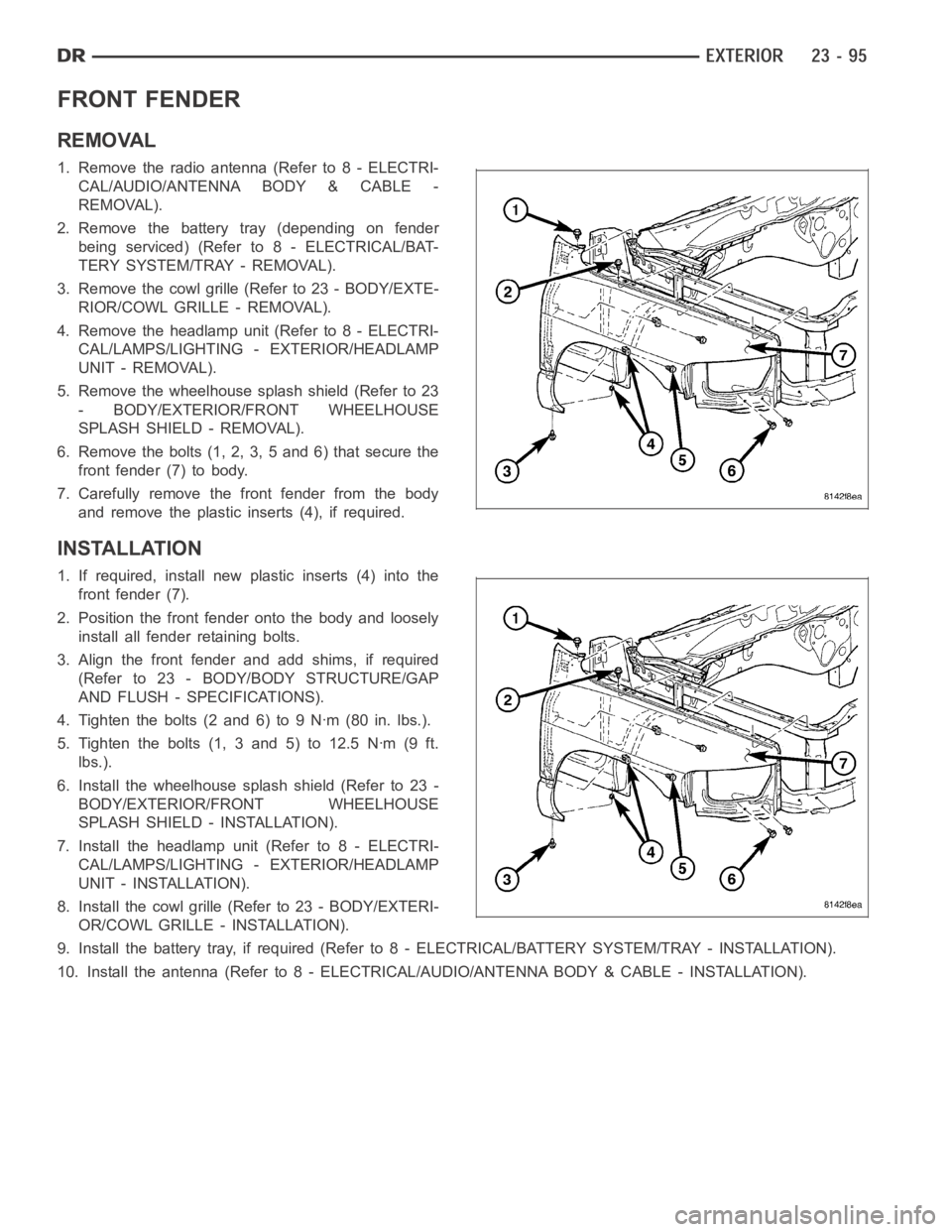
FRONT FENDER
REMOVAL
1. Remove the radio antenna (Refer to 8 - ELECTRI-
CAL/AUDIO/ANTENNA BODY & CABLE -
REMOVAL).
2. Remove the battery tray (depending on fender
beingserviced)(Referto8-ELECTRICAL/BAT-
TERY SYSTEM/TRAY - REMOVAL).
3. Remove the cowl grille (Refer to 23 - BODY/EXTE-
RIOR/COWL GRILLE - REMOVAL).
4. Remove the headlamp unit (Refer to 8 - ELECTRI-
CAL/LAMPS/LIGHTING - EXTERIOR/HEADLAMP
UNIT - REMOVAL).
5. Remove the wheelhouse splash shield (Refer to 23
- BODY/EXTERIOR/FRONT WHEELHOUSE
SPLASH SHIELD - REMOVAL).
6. Remove the bolts (1, 2, 3, 5 and 6) that secure the
front fender (7) to body.
7. Carefully remove the front fender from the body
and remove the plastic inserts (4), if required.
INSTALLATION
1. If required, install new plastic inserts (4) into the
front fender (7).
2. Position the front fender onto the body and loosely
install all fender retaining bolts.
3. Align the front fender and add shims, if required
(Refer to 23 - BODY/BODY STRUCTURE/GAP
AND FLUSH - SPECIFICATIONS).
4. Tighten the bolts (2 and 6) to 9 Nꞏm (80 in. lbs.).
5. Tighten the bolts (1, 3 and 5) to 12.5 Nꞏm (9 ft.
lbs.).
6. Install the wheelhouse splash shield (Refer to 23 -
BODY/EXTERIOR/FRONT WHEELHOUSE
SPLASH SHIELD - INSTALLATION).
7. Install the headlamp unit (Refer to 8 - ELECTRI-
CAL/LAMPS/LIGHTING - EXTERIOR/HEADLAMP
UNIT - INSTALLATION).
8. Install the cowl grille (Refer to 23 - BODY/EXTERI-
OR/COWL GRILLE - INSTALLATION).
9. Install the battery tray, if required (Refer to 8 - ELECTRICAL/BATTERY SYSTEM/TRAY - INSTALLATION).
10. Install the antenna (Refer to 8 - ELECTRICAL/AUDIO/ANTENNA BODY & CABLE - INSTALLATION).
Page 4436 of 5267
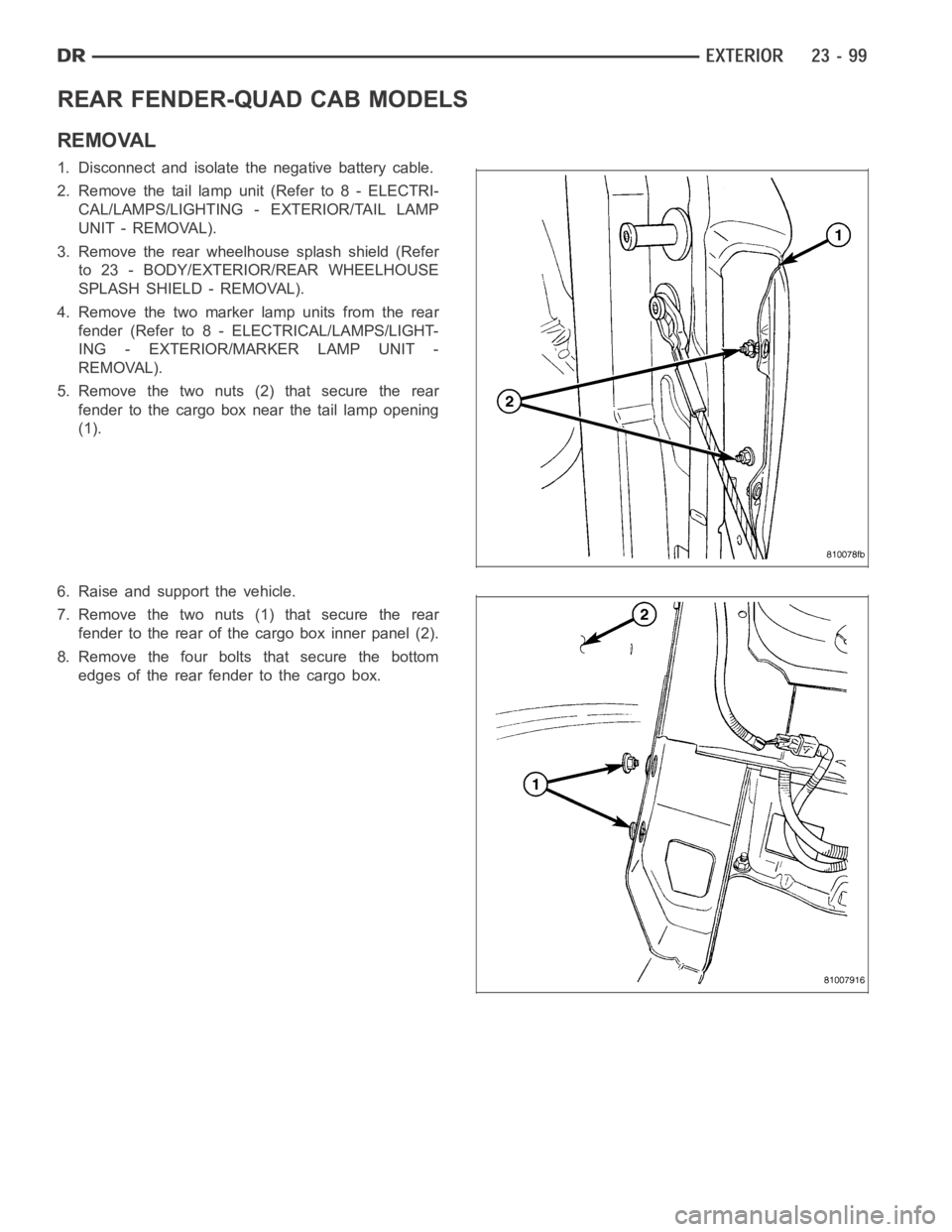
REAR FENDER-QUAD CAB MODELS
REMOVAL
1. Disconnect and isolate the negative battery cable.
2. Remove the tail lamp unit (Refer to 8 - ELECTRI-
CAL/LAMPS/LIGHTING - EXTERIOR/TAIL LAMP
UNIT - REMOVAL).
3. Remove the rear wheelhouse splash shield (Refer
to 23 - BODY/EXTERIOR/REAR WHEELHOUSE
SPLASH SHIELD - REMOVAL).
4. Remove the two marker lamp units from the rear
fender (Refer to 8 - ELECTRICAL/LAMPS/LIGHT-
ING - EXTERIOR/MARKER LAMP UNIT -
REMOVAL).
5. Remove the two nuts (2) that secure the rear
fender to the cargo box near the tail lamp opening
(1).
6. Raise and support the vehicle.
7. Remove the two nuts (1) that secure the rear
fender to the rear of the cargo box inner panel (2).
8. Remove the four bolts that secure the bottom
edges of the rear fender to the cargo box.
Page 4439 of 5267
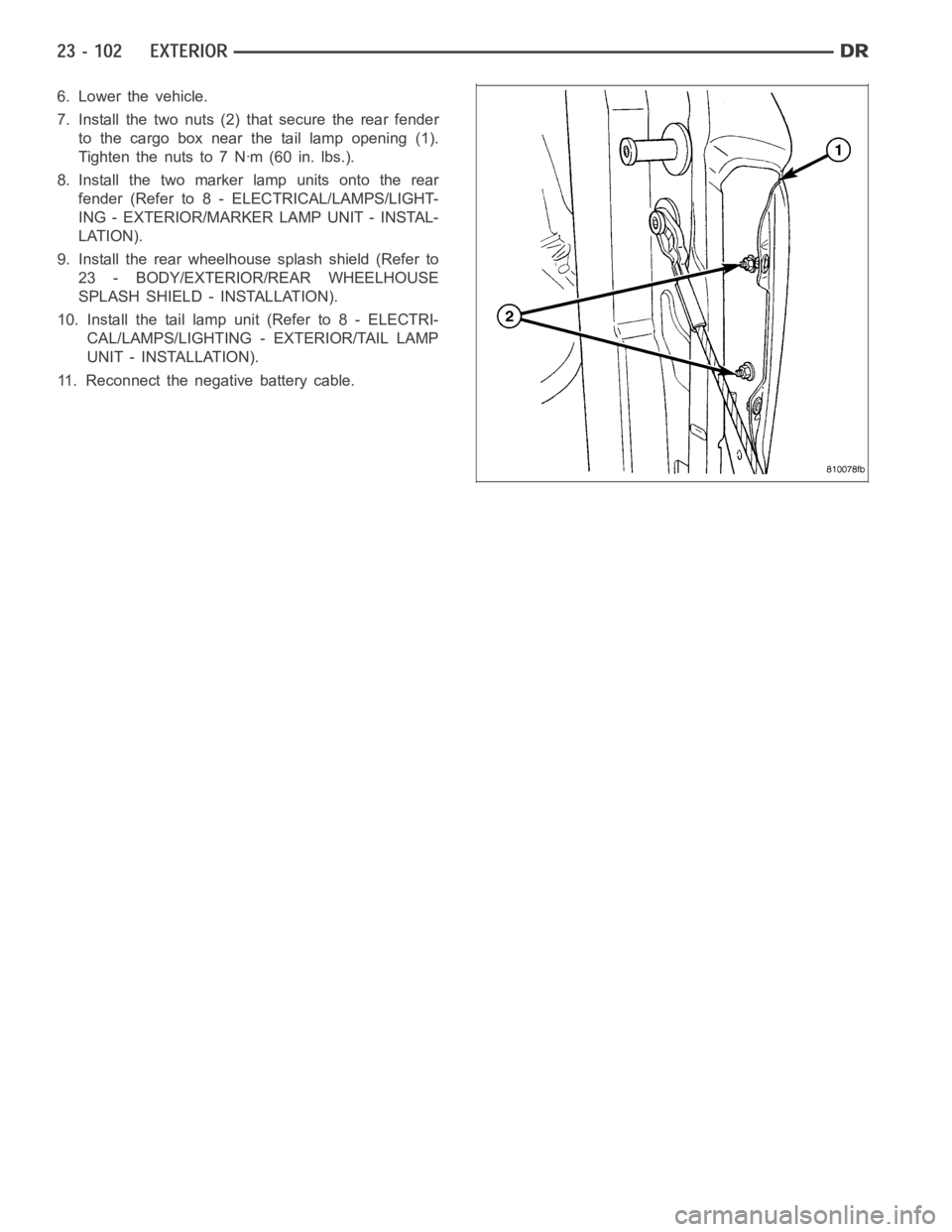
6. Lower the vehicle.
7. Install the two nuts (2) that secure the rear fender
to the cargo box near the tail lamp opening (1).
Tightenthenutsto7Nꞏm(60in.lbs.).
8. Install the two marker lamp units onto the rear
fender (Refer to 8 - ELECTRICAL/LAMPS/LIGHT-
ING - EXTERIOR/MARKER LAMP UNIT - INSTAL-
LATION).
9. Install the rear wheelhouse splash shield (Refer to
23 - BODY/EXTERIOR/REAR WHEELHOUSE
SPLASH SHIELD - INSTALLATION).
10. Install the tail lamp unit (Refer to 8 - ELECTRI-
CAL/LAMPS/LIGHTING - EXTERIOR/TAIL LAMP
UNIT - INSTALLATION).
11. Reconnect the negative battery cable.
Page 4446 of 5267
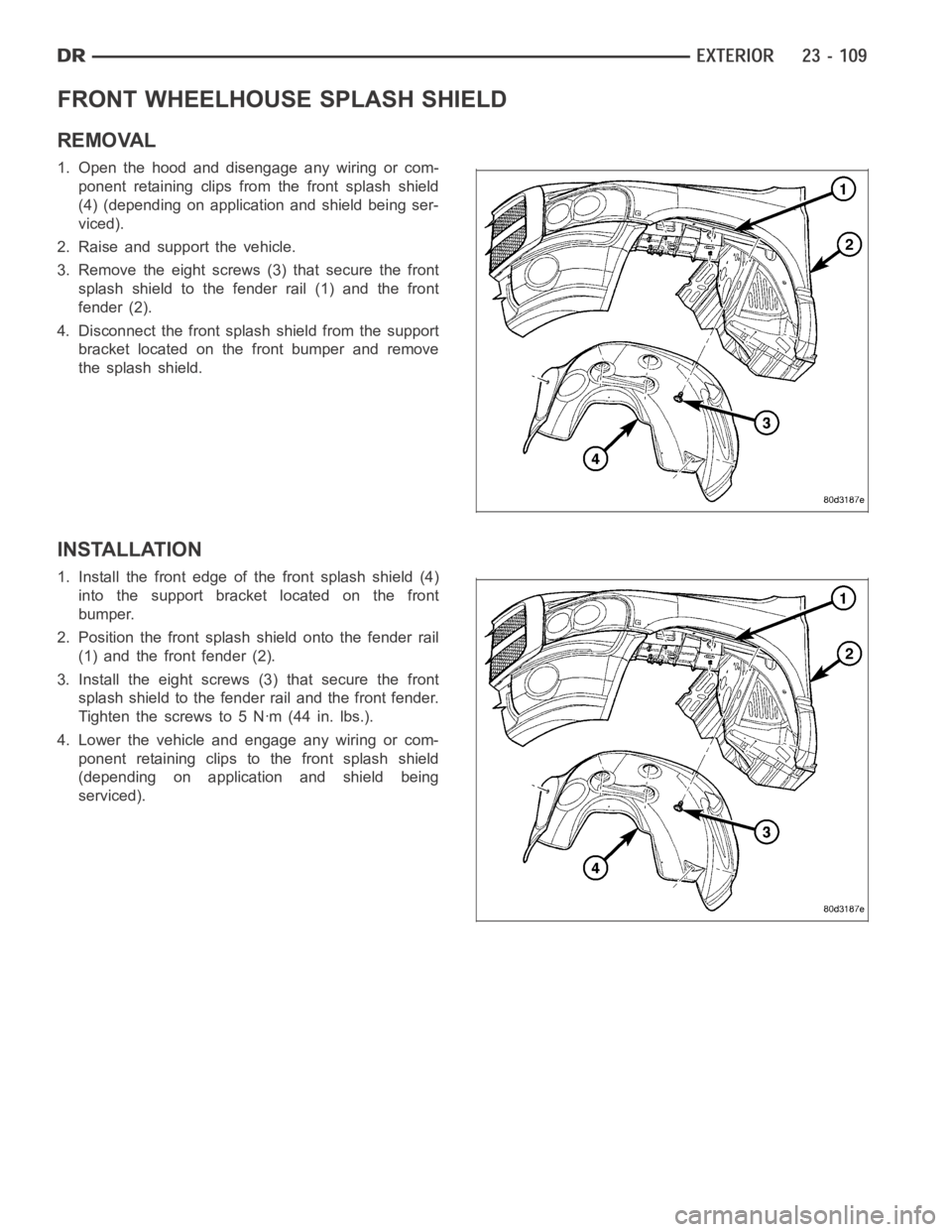
FRONT WHEELHOUSE SPLASH SHIELD
REMOVAL
1. Open the hood and disengage any wiring or com-
ponent retaining clips from the front splash shield
(4) (depending on application and shield being ser-
viced).
2. Raise and support the vehicle.
3. Remove the eight screws (3) that secure the front
splash shield to the fender rail (1) and the front
fender (2).
4. Disconnect the front splash shield from the support
bracket located on the front bumper and remove
the splash shield.
INSTALLATION
1. Install the front edge of the front splash shield (4)
into the support bracket located on the front
bumper.
2. Position the front splash shield onto the fender rail
(1) and the front fender (2).
3. Install the eight screws (3) that secure the front
splash shield to the fender rail and the front fender.
Tighten the screws to 5 Nꞏm (44 in. lbs.).
4. Lower the vehicle and engage any wiring or com-
ponent retaining clips to the front splash shield
(depending on application and shield being
serviced).
Page 4447 of 5267
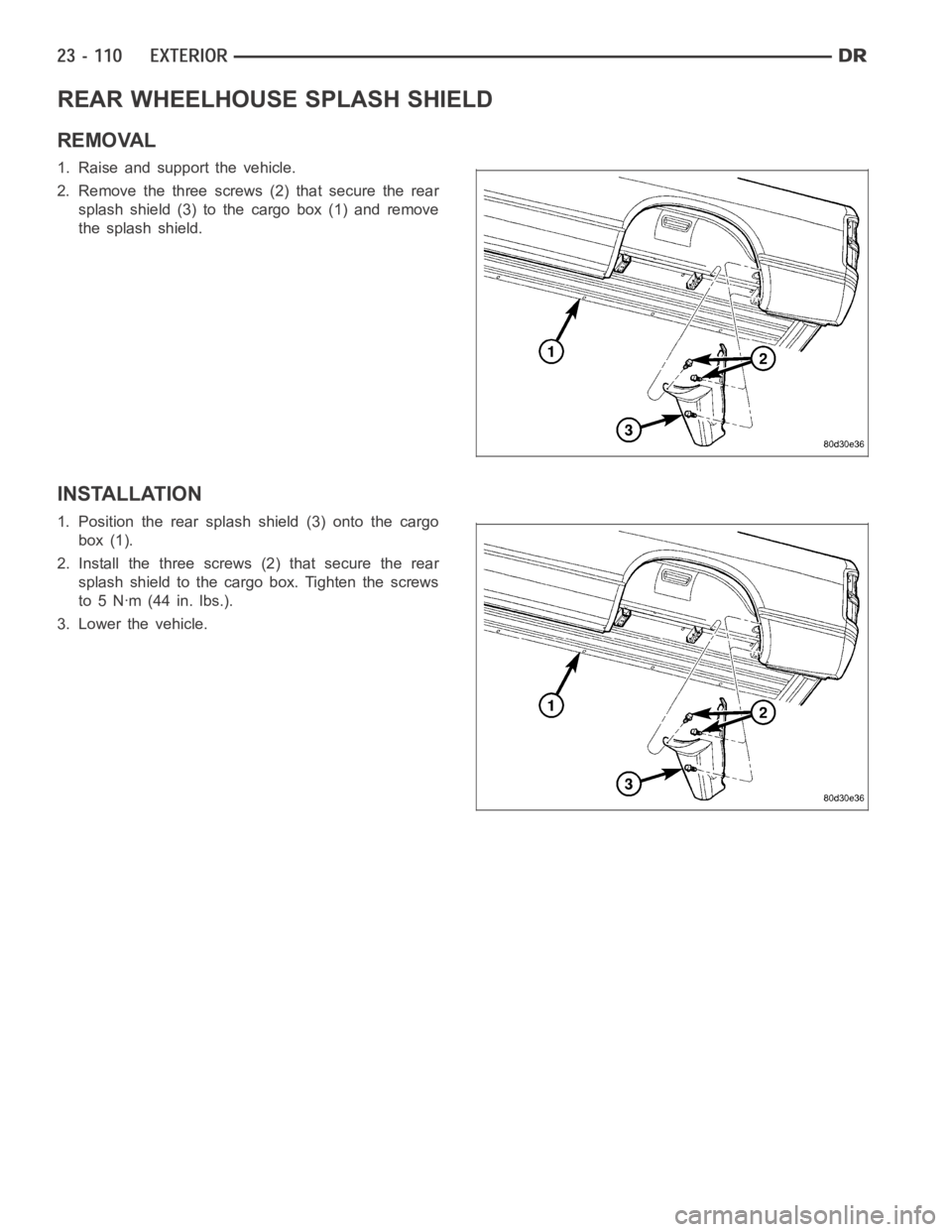
REAR WHEELHOUSE SPLASH SHIELD
REMOVAL
1. Raise and support the vehicle.
2. Remove the three screws (2) that secure the rear
splash shield (3) to the cargo box (1) and remove
the splash shield.
INSTALLATION
1. Position the rear splash shield (3) onto the cargo
box (1).
2. Install the three screws (2) that secure the rear
splash shield to the cargo box. Tighten the screws
to5Nꞏm(44in.lbs.).
3. Lower the vehicle.